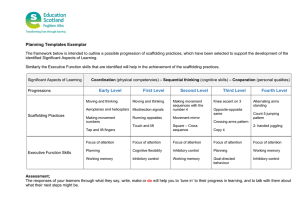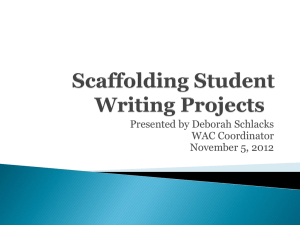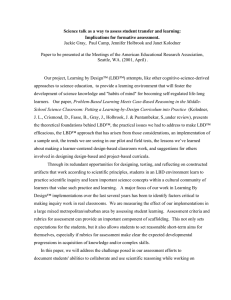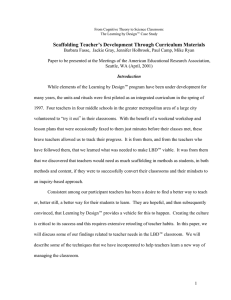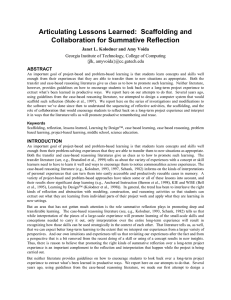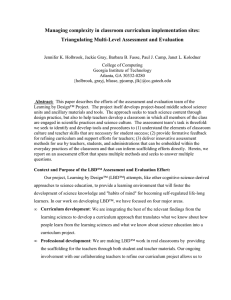LST Qualifying Exam Fall, 2006 Oct. 26, 2006
advertisement
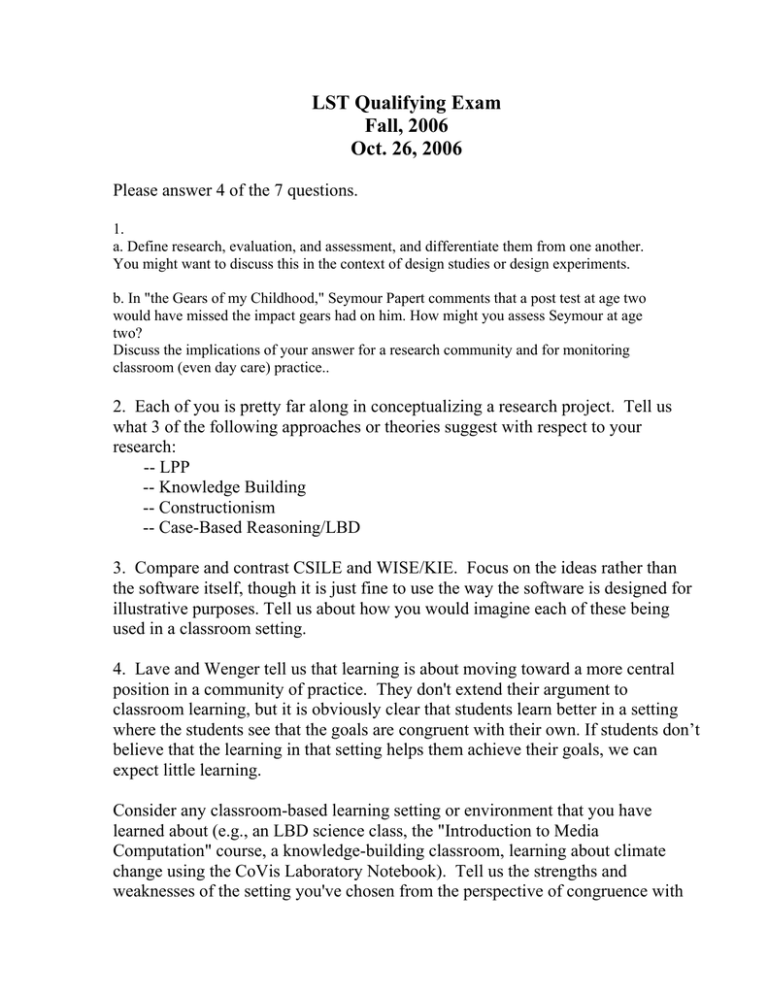
LST Qualifying Exam Fall, 2006 Oct. 26, 2006 Please answer 4 of the 7 questions. 1. a. Define research, evaluation, and assessment, and differentiate them from one another. You might want to discuss this in the context of design studies or design experiments. b. In "the Gears of my Childhood," Seymour Papert comments that a post test at age two would have missed the impact gears had on him. How might you assess Seymour at age two? Discuss the implications of your answer for a research community and for monitoring classroom (even day care) practice.. 2. Each of you is pretty far along in conceptualizing a research project. Tell us what 3 of the following approaches or theories suggest with respect to your research: -- LPP -- Knowledge Building -- Constructionism -- Case-Based Reasoning/LBD 3. Compare and contrast CSILE and WISE/KIE. Focus on the ideas rather than the software itself, though it is just fine to use the way the software is designed for illustrative purposes. Tell us about how you would imagine each of these being used in a classroom setting. 4. Lave and Wenger tell us that learning is about moving toward a more central position in a community of practice. They don't extend their argument to classroom learning, but it is obviously clear that students learn better in a setting where the students see that the goals are congruent with their own. If students don’t believe that the learning in that setting helps them achieve their goals, we can expect little learning. Consider any classroom-based learning setting or environment that you have learned about (e.g., an LBD science class, the "Introduction to Media Computation" course, a knowledge-building classroom, learning about climate change using the CoVis Laboratory Notebook). Tell us the strengths and weaknesses of the setting you've chosen from the perspective of congruence with students’ learning goals, considering the following in your answer: a. What learning goals do you see that the designers had for the setting that you have chosen? b. What learning goals do you think that students might have in that setting? c. Is the setting congruent with the students’ learning goals? Is the setting authentic in the Schaffer and Resnick sense? d. Explain the learning results that you know about for that setting in terms of the authenticity. 5. Considering what you know about scaffolding and any external reading you may have done beyond the reading list (e.g., the JLS special issue on scaffolding): a. Provide a definition of scaffolding. b. Find any two papers that you have read that call what they do “scaffolding” where the definitions of scaffolding differ in some respect. How does it differ and why? c. For each of the below supports, consider if it should be considered scaffolding according to your definition. If your answer would be context dependent, explain the context under which it would be scaffolding. An electronic encyclopedia, like Wikipedia. A menu system for an application like MS Word. Prompts for note types in CSILE or CoVis Laboratory Notebook. The column headings on an LBD whiteboard. 6. Technology has changed immensely since Logo was first invented in the late 1960's. We now have cell phones, iPods, Google, Wikipedia, laptops, Lego, cricket robots, and so on. Imagine that you have a team with the talents of Seymour Papert, Wally Feurzeig, and Danny Bobrow and the resources of a wellfunded research lab like BBN. You plan to create the Logo of the 21st Century. For BOTH of the below statements, explain in what ways it is correct, and in what ways it is wrong. a. The Logo of the 21st Century shouldn't look much different than the Logo of the 1960's. While the technology has changed, the basic learning objectives of mathematics and higher-order thinking skills are essentially the same--the human mind hasn't changed much in the last 40 years. b. Logo of the 21st Century has to be about the technology that students use today. Students in the 1960's didn't have as much computing technology in their daily lives, so any computer application at all was motivating and clearly relevant. Today, a Logo that doesn't run on cell phones and doesn't help students understand the technology in their daily lives is irrelevant and inherently unmotivating. 7. Transer (a) It seems like the hardest environment for promoting transferable learning is school. Explain why, using your understanding of cognitive, socio-cognitive, and cultural approaches to learning. (b) Apply your understanding of transfer to your own work. Why do you think that students will transfer learning from your learning setting to some other setting? What do you think will transfer?

